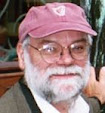When I talked to my cousin Tom Quinn recently, he told me of how my Dad treated a severe asthma attack when he was in the Navy (the same approach was used when Dad was a child in Willoughby in the 1920's and 1930's).
The following is pasted from an online version of The American Journal of Respiratory and Critical Care Medicine, March 18, 2005. Click here for the original article, with illustrations: http://ajrccm.atsjournals.org/cgi/content/full/171/11/1202
This article explains the use of asthma cigarettes, and in the original version, shows images of these cigarette brands used for acute asthmatic episodes.
ANTICHOLINERGIC ASTHMA TREATMENT
In Stedman's Twentieth Century Practice of Modern Medical Science, Stewart and Gibson (3) suggest that one of the primary treatments for an asthmatic paroxysm was the use of belladonna alkaloids; often these were delivered by smoking "asthma cigarettes" (Figure 1).
Smoking tobacco benefits a few, but the addition of a little stramonium to tobacco, or the smoking of cigarettes composed largely of stramonium, is of far greater service [in the treatment of an asthmatic paroxysm]. There are many forms of cigarettes sold by the druggists.
View larger version (70K):[in this window][in a new window]
Figure 1. Asthma cigarettes were used to deliver alkaloids with bronchodilator properties. They were sold commercially for asthma treatment until just before the middle of the 20th century. (Courtesy of Mark Saunders and his "Inhalatorium," www.inhalatorium.com)
Stramonium is the dried leaf and the flowering or fruiting tops of the plant, Datura stramonium. This is also referred to as the thorn-apple plant. The active ingredients in this were alkaloids of belladonna, which we now know had the effect of inhibiting cholinergic neurotransmission and thereby reflex bronchoconstriction.
In 1914, in the eighth edition of the Principles and Practice of Medicine, Osler (8) points out that hypodermic injections of pilocarpine can be effective in the treatment of asthma. He also claims that the sedative antispasmodics, such as belladonna, "may be given in solution or used in the form of cigarettes. Nearly all the popular remedies either in this form or in pastilles contain some plant of the order Solanaceae ... Excellent cigarettes are now manufactured and asthmatics try various sorts since one form benefits one patient, another form another patient."
Thus, in 1914, anticholinergics by injection or inhalation were considered as first-line asthma therapies. Osler also made the important observation of the intraindividual differences in the response to asthma treatment. We now appreciate that these differences may reflect genetic variations in the mechanisms leading to the asthmatic response among subjects.
In the 1927 edition of Cecil's A Text-book of Medicine, Francis Rackemann (9) again suggests the use of the smoke of stramonium leaves, atropine, and belladonna. In the seventh edition of Cecil's A Textbook of Medicine, published in 1947, Rackemann (10) still suggests the use of asthma powders or asthma cigarettes with the active ingredient consisting of belladonna-type alkaloids. However, by 1975, when the 14th edition of the textbook was published, belladonna alkaloids were not considered a significant enough part of asthma treatment to be included by J.B.L. Howell (11).
Asthma can still be a serious problem for some people, but today we have albuterol inhalers and other medicines that usually help sudden and severe asthma attacks. I don't know if asthma powders and asthma cigarettes are still available. Still, it happens that many people are still brought to emergency rooms in the grip of an asthma attack (it happened to my youngest daughter one Easter Sunday many years ago).
Subscribe to:
Post Comments (Atom)


No comments:
Post a Comment